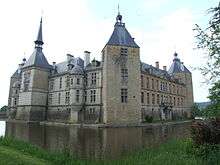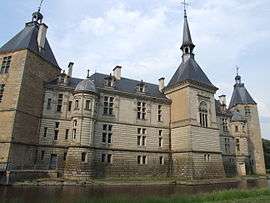Château de Sully
The Château de Sully, situated between Autun and Beaune (Saône-et-Loire), is the largest of the Renaissance châteaux of southern Burgundy. Paired outbuildings of a more vernacular character face each other across a grassed forecourt, while to the rear is the vegetable garden, fenced by fruit trees. The château is approached by an axial stone bridge across its moat. The façades express the traditionally defensive character of the rez-de-chaussée, the ground floor, and the richer, more open aspect of the piano nobile, articulated by pilasters. Under the central pediment that breaks the line of a traditional sloping slate roof, the arched portal is scaled to admit riders and carriages. Four similarly-treated ranges, flanked by matching angled corner towers with pyramidal roofs and surrounded by the moat, enclose a Renaissance courtyard built for the Maréchal de Saulx-Tavanes, confident of Catherine de' Medici.
| Château de Sully | |
|---|---|
 Château de Sully and moat | |
| Coordinates | 47°00′39″N 4°28′24″E |
| Built | 1570-1610 |
| Built for | Gaspard de Saulx-Tavannes |
| Original use | Château |
| Current use | Tourist attraction and historical research |
| Architect | Nicolas Ribonnier |
| Architectural style(s) | Renaissance |
| Website | http://www.chateaudesully.com/ |
| Designated | 1995 |
 Location of Château de Sully in France | |
The splendor of the interior courtyard shows that this château, though symmetrical and regular, still looks inwards. A rusticated ground floor with arch-headed windows supports a main floor where paired pilaster-defined bays that alternate between windows and coved niches.
| Wikimedia Commons has media related to Château de Sully. |
The historic chateau of the MacMahon family, from the marriage of the heiress Charlotte de Morey, with Jean-Baptiste de MacMahon, Sully was the birthplace of the monarchist Field Marshal, Patrice MacMahon, duc de Magenta, who was President of the French Third Republic from 1873 to 1879. The Château de Sully remains the home of the present duchesse de Magenta and her family.
The château of Henri IV's minister, Maximilien de Béthune and the ducs de Sully, is the Château de Sully-sur-Loire.
Gallery
 Courtyard alley with Common buildings on either side
Courtyard alley with Common buildings on either side Closeup of the Neo-Renaissance facade of the castle
Closeup of the Neo-Renaissance facade of the castle The west facade and the bridge of Pierre
The west facade and the bridge of Pierre